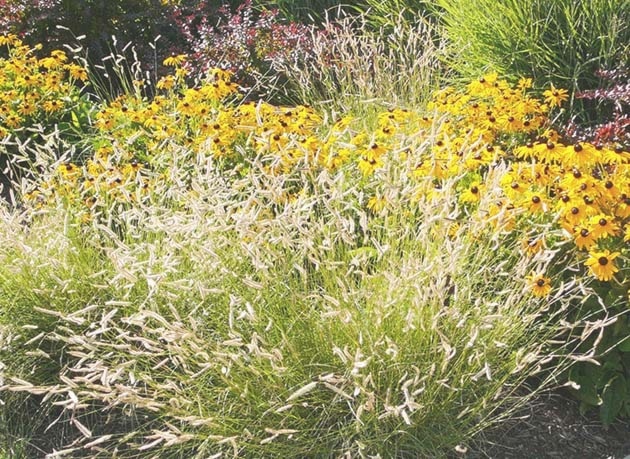Here are some alternatives to create a lawn-like look without the weekly chores of mowing and edging or the cost of heavy watering needed for a green, conventional lawn.
Before planting, remove all weeds and keep the area weeded while new plantings grow in.
To break up clay and improve drainage in heavy soil, till in a four inch depth of organic matter such as Glenmore Grow or OgoGrow.
For fast-draining, sandy soil, adding organic matter is important to increase nutrients and retain moisture.
All plants need regular watering the first year or until they become established. Plants mentioned in this column are deer-proof.
The first two options below would be good if you need a lawn that is heavily used such as for children to play on.
Enviro-Turf: a lawn seed mix containing four tough fescue grasses and perennial rye grass. Their deep roots make this a low water turf option. Once established, it needs a deep watering only once every 10 days to two weeks to stay green during dry summers. It grows slowly so there is less mowing.
Enviro-Turf has been extensively tested for many years on school grounds in the Christina Lake area. It looks almost identical to Kentucky blue grass.
Yarrow (Achillea millefolium): an Okanagan native perennial that can be used as a very drought tolerant lawn alternative. Fuzzy foliage stays grey-green year round. Plants grow to about 12 inches tall with a white bloom in June, sometimes re-blooming in August. They self-seed readily, helping to fill in to a solid weed-suppressing mass.
Yarrow stands up to foot and animal traffic, however it’s best to mow down flower stems soon after they form, while still soft. Mature stems are tough and pokey, causing discomfort for bare feet and animal paws.
With about three mowings a season, plants can be kept as a short, functional, turf-like ground cover.
Blue grama grass (Bouteloua gracilis): a very fine-textured, water-wise grass native to the short grass prairie grows to 12 to 18 inches tall. If planted six inches apart this clump-forming grass quickly becomes a dense ground cover and can be mowed occasionally to create a lawn. An option would be to just mow paths as needed.
It has very decorative flowers and seed heads that stand up well through winter.
Prairie dropseed (Sporobolus heterolepsis): another short-grass prairie native. This very low maintenance, long-lived plant, forms fine-leaved tussocks that turn burnt orange in fall.
Blue grama and prairie dropseed each respond well to a deep watering once a month during hot, dry weather.
Check www.blue
stem.ca for extensive information on ornamental grasses; how to remove turf; and how to make a low-mow, low-grow, water-wise lawn.
I will be teaching my two-night Introduction to Xeriscape Gardening class Sep. 21, 26, 28 and Oct. 3 from 7 p.m. to 9 p.m. at St Michael and All Angels Cathedral Hall, Kelowna. For details and to register go to: www.okanaganxeriscape.org.
